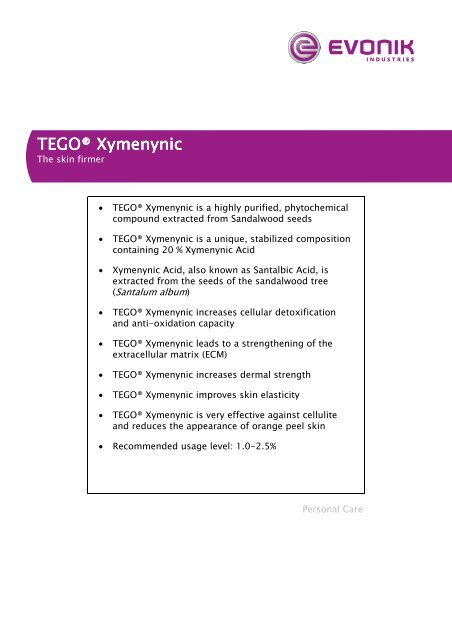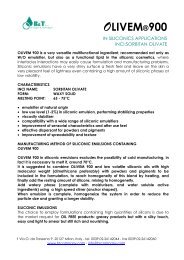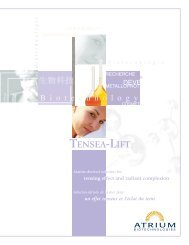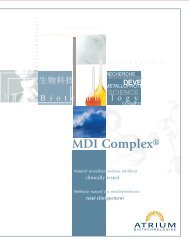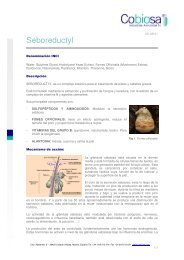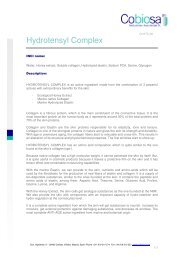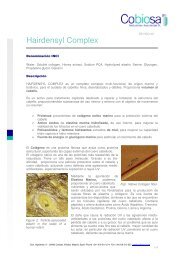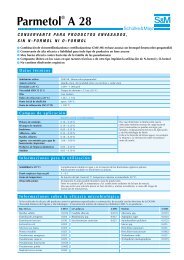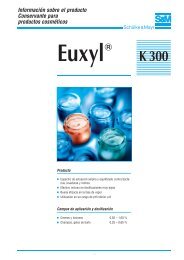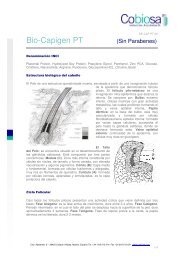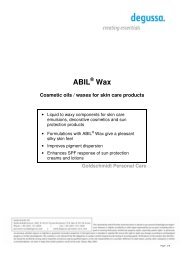DS TEGO Xymenynic E - Quetzal Quimica
DS TEGO Xymenynic E - Quetzal Quimica
DS TEGO Xymenynic E - Quetzal Quimica
You also want an ePaper? Increase the reach of your titles
YUMPU automatically turns print PDFs into web optimized ePapers that Google loves.
<strong>TEGO</strong>® <strong>Xymenynic</strong><br />
The skin firmer<br />
• <strong>TEGO</strong>® <strong>Xymenynic</strong> is a highly purified, phytochemical<br />
compound extracted from Sandalwood seeds<br />
• <strong>TEGO</strong>® <strong>Xymenynic</strong> is a unique, stabilized composition<br />
containing 20 % <strong>Xymenynic</strong> Acid<br />
• <strong>Xymenynic</strong> Acid, also known as Santalbic Acid, is<br />
extracted from the seeds of the sandalwood tree<br />
(Santalum album)<br />
• <strong>TEGO</strong>® <strong>Xymenynic</strong> increases cellular detoxification<br />
and anti-oxidation capacity<br />
• <strong>TEGO</strong>® <strong>Xymenynic</strong> leads to a strengthening of the<br />
extracellular matrix (ECM)<br />
• <strong>TEGO</strong>® <strong>Xymenynic</strong> increases dermal strength<br />
• <strong>TEGO</strong>® <strong>Xymenynic</strong> improves skin elasticity<br />
• <strong>TEGO</strong>® <strong>Xymenynic</strong> is very effective against cellulite<br />
and reduces the appearance of orange peel skin<br />
• Recommended usage level: 1.0-2.5%<br />
Personal Care
INCI Name (PCPC<br />
(<br />
name)<br />
Caprylic/Capric Triglyceride; <strong>Xymenynic</strong> Acid<br />
(proposed)<br />
Chemical and physical properties<br />
(not part of specifications)<br />
Form<br />
Active matter<br />
yellowish solution<br />
approx. 20 % <strong>Xymenynic</strong> Acid<br />
Santalum album, the sandalwood tree, grows in the<br />
mountain regions of South India. All trees are owned<br />
by the government, and the harvest of the trees is<br />
strictly controlled. The seeds are collected by the<br />
Indian Government Forest Department in order to<br />
maintain the sustainability of the species.<br />
Traditionally, the plant is used in Arjuvedic<br />
treatments to make the skin smoother, tauter and<br />
more velvet.<br />
<strong>Xymenynic</strong> Acid is extracted from the seeds of the<br />
sandalwood tree using a standardized process. It is a<br />
yellow, crystalline powder with the following<br />
structure:<br />
Figure 1: Chemical structure of <strong>Xymenynic</strong> Acid<br />
Due to the triple and double bond in the molecule, it<br />
is sensitive to oxidation. To stabilize <strong>Xymenynic</strong><br />
Acid, it is solubilized in Caprylic/Capric Triglyceride<br />
(<strong>TEGO</strong>SOFT® CT). To guarantee color stability,<br />
Tocopherol is also present in this composition.<br />
Properties<br />
• in vitro evaluation<br />
of ECM strengthening<br />
properties of <strong>TEGO</strong> ® <strong>Xymenynic</strong><br />
The extracellular matrix (ECM) is by volume the<br />
largest component of normal skin and gives the skin<br />
its unique properties of elasticity, tensile strength<br />
and compressibility. Therefore, an accurate<br />
composition of the ECM proteins, especially a proper<br />
production of its major components, collagen and<br />
hyaluronic acid, is very important for strong and<br />
tight-looking skin.<br />
The anti-hyaluronidase and anti-collagenase<br />
activities of <strong>Xymenynic</strong> Acid were analysed.<br />
Method: For hyaluronidase inhibition assay,<br />
hyaluronic acid substrate (0.015 % in phosphate<br />
buffer, pH 5.35) was incubated for 45 minutes at<br />
37°C with hyaluronidase enzyme solution (Sigma, 5<br />
g/ml in phosphate buffer, pH 7) and various<br />
concentrations (2-50 g/ml) of <strong>Xymenynic</strong> Acid.<br />
Undigested hyaluronic acid was precipitated with 1%<br />
cetylpyridinum chloride. The absorbance of<br />
undigested hyaluronic acid was measured at 600 nm.<br />
A decrease in absorbance correlates with an<br />
increasing amount of digested hyaluronic acid.<br />
For collagenase inhibition assay varying<br />
concentrations of <strong>Xymenynic</strong> Acid (3-50 g/ml) were<br />
pre-incubated with fluorescein conjugated DQ<br />
gelatine substrate from pig skin (EnzChek<br />
collagenase assay kit). After 10 minutes Collagenase<br />
Type IV enzyme from Clostridium histolyticum<br />
(EnzChek collagenase assay kit) was added and<br />
fluorescence intensity was measured after 30<br />
minutes of incubation at 485 nm (emission<br />
wavelength) and 520 nm (excitation wavelength). An<br />
increase in fluorescence is proportional to proteolytic<br />
activity, and fluorescence is quenched in the<br />
presence of an inhibitor.<br />
Results: <strong>TEGO</strong>® <strong>Xymenynic</strong> inhibits hyaluronidase<br />
activity about 50 % at a concentration of 23 g/ml<br />
<strong>Xymenynic</strong> Acid. <strong>TEGO</strong>® <strong>Xymenynic</strong> inhibits<br />
collagenase activity about 50 % at a concentration of<br />
13 g/ml <strong>Xymenynic</strong> Acid.<br />
The inhibition of those enzymes by <strong>TEGO</strong>®<br />
<strong>Xymenynic</strong> prevents degradation of hyaluronic acid<br />
and collagen and leads to an overall strengthening of<br />
the ECM, which in turn leads to an improvement in<br />
skin elasticity and tighter looking skin.<br />
• in vitro evaluation<br />
of effects of<br />
<strong>TEGO</strong>® <strong>Xymenynic</strong> on cellular detoxification and<br />
anti-oxidation capacity<br />
The skin is highly susceptible to harmful external<br />
and internal influences causing cell damage. Free<br />
radicals and toxic molecules can accumulate in skin<br />
cells and interact with cellular macromolecules, such<br />
as DNA, lipids and proteins. As a consequence, the<br />
metabolic capacity of the cells is impaired,<br />
biosynthesis of macromolecules declines and severe<br />
structural alterations occur. This in turn leads to a<br />
loss of skin elasticity and strength. To protect the<br />
cells from those harmful effects, sophisticated antioxidation<br />
and detoxification mechanisms have been<br />
evolved by the skin.<br />
Method: 1) To initially identify the biological activity<br />
of <strong>TEGO</strong>® <strong>Xymenynic</strong>, reconstructed human<br />
epidermis models (SkinEthic) were topically treated<br />
with a formulation containing 0.5 % <strong>Xymenynic</strong> Acid<br />
for 48 h. RNA from vehicle- and verum-treated skin<br />
models was extracted and reversely transcribed into<br />
cDNA, labelled with fluorescent dyes and analyzed by<br />
DNA-Chip technology to characterize genome wide<br />
gene expression (Affymetrix® HGU133 GeneChips).<br />
The results of this study were then verified by<br />
quantitative real-time PCR (qRT-PCR) in an<br />
independent experiment.<br />
2) To extend the application range and to confirm<br />
the analysed activity of <strong>TEGO</strong>® <strong>Xymenynic</strong>, a second<br />
study with UVB-stimulated cells was performed.
Primary human epidermal keratinocytes were<br />
cultivated in medium containing 2.8 ppm <strong>Xymenynic</strong><br />
Acid resp. in medium without any test substance for<br />
24 h. After this pre-incubation, the cells were<br />
exposed to a dose of 160 J/m 2 UVB radiation, which<br />
previously was found to be optimal to induce gene<br />
expression without affecting viability in this cell<br />
type. After irradiation, cells were cultivated for<br />
another 24h, either in the presence or in the absence<br />
of <strong>Xymenynic</strong> Acid. Subsequently cells were<br />
harvested and total RNA was extracted, reversely<br />
transcribed into cDNA and applied for qRT-PCR to<br />
analyze expression of genes involved in the<br />
glutathione pathway. The results were normalized to<br />
18S rRNA and compared to vehicle control.<br />
Results: DNA-Chip analysis suggested a stimulatory<br />
effect on the glutathione system. This hypothesis<br />
was confirmed independently by qRT-PCR<br />
measurements. In particular, the genes encoding<br />
glutamate cystein ligase, which is the first rate<br />
limiting enzyme of glutathione synthesis, were found<br />
to be induced. Both subunits of this enzyme (GCLM &<br />
GCLC) were significantly up-regulated. In addition,<br />
the genes coding for glutathione peroxidise 2 (GPX2)<br />
and glutathione transferase (MGST1) were also found<br />
to be induced by <strong>Xymenynic</strong> Acid. Both enzymes play<br />
key roles in the elimination of hydrogen peroxide<br />
and detoxification of other substances.<br />
UVB irradiation of human keratinocytes induced the<br />
expression of all major components of the<br />
glutathione system. This protective cellular response<br />
was extremely boosted by the application of<br />
<strong>Xymenynic</strong> Acid.<br />
ingredient was investigated by a dermal absorption<br />
assay based on porcine skin.<br />
Method: Prior to the study the integrity of the used<br />
porcine skin was verified by both the measurement<br />
of the transepidermal water loss (TEWL), and caffeine<br />
penetration.<br />
A skin layer of defined thickness, 1000 m, was cut<br />
off with a dermatome (containing the stratum<br />
corneum, epidermis, and a part of the dermis). The<br />
skin samples were mounted onto Franz’ diffusion<br />
cells with the epidermis side up. The dermis side was<br />
completely covered with the receptor medium (PBS<br />
buffer, pH 7.0). Afterwards approx. 20 – 40 mg/cm²<br />
of the test formulation were applied on the skin and<br />
spread evenly by rubbing the formulation on the<br />
skin. The diffusion cells were placed in a climatic<br />
chamber (32 °C, 50 % relative humidity). During the<br />
experiment the receptor medium was stirred with a<br />
magnetic stirrer at 300 rpm.<br />
After 24 ± 1 h, the residual test formulation on the<br />
porcine skin was rinsed off with a cotton swab, and<br />
the skin samples were cut into small pieces for<br />
extraction overnight. Finally, the amount of<br />
<strong>Xymenynic</strong> Acid in the receptor medium, the rinseoff<br />
medium, and the skin extract was analysed by<br />
GC.<br />
Result: The bioavailability of <strong>Xymenynic</strong> Acid in<br />
porcine skin has been shown to be approx. 40%<br />
depending on the oil.<br />
This demonstrates a high bioavailability of <strong>TEGO</strong>®<br />
<strong>Xymenynic</strong> in the skin which is in line with the<br />
theoretical logPO/W value of <strong>Xymenynic</strong> Acid of 5.7.<br />
Figure 1: Expression of different genes involved in<br />
glutathione metabolism<br />
<strong>TEGO</strong>® <strong>Xymenynic</strong> increases cellular detoxification<br />
under unstressed conditions, as well as under<br />
physiological stress. Mediated by the improvement<br />
of the physiological anti-oxidation mechanisms it<br />
reduces inflammation and alleviates symptoms of<br />
impaired skin.<br />
• Ex vivo skin penetration analysis of <strong>TEGO</strong>®<br />
<strong>Xymenynic</strong><br />
In order to have the optimal performance, it is<br />
important that the active ingredient reaches the<br />
proper site of action. The bioavailability of the active<br />
• In vivo evaluation of <strong>TEGO</strong> ® <strong>Xymenynic</strong>: : skin<br />
elasticity ity (Cutometer)<br />
With the above mentioned in vitro studies, it was<br />
shown that <strong>TEGO</strong>® <strong>Xymenynic</strong> strengthens the ECM.<br />
From this result it can be deduced that <strong>TEGO</strong>®<br />
<strong>Xymenynic</strong> should improve skin elasticity. The aim of<br />
the following in vivo study was to verify this<br />
hypothesis.<br />
Method: For the study 20 volunteers were recruited.<br />
They received two formulations; one containing 0.5 %<br />
<strong>Xymenynic</strong> Acid, the other one containing no active<br />
ingredient (vehicle). They applied one test formulation<br />
on the left inner forearm and the other on the right<br />
inner forearm twice daily over a period of 8 weeks.<br />
At the beginning of the study, and after 8 weeks, skin<br />
elasticity was assessed using a Cutometer (Courage &<br />
Khazaka, Cologne). The difference of the elasticity<br />
parameters R1, R2, R5 and R6 compared to vehicle was<br />
calculated after 8 weeks application.<br />
The measurements were performed in a climatic room<br />
at 21 - 22 °C and 50 % relative humidity. Before the<br />
measurement started the volunteers had to acclimatize<br />
for at least 15 min.
After 8 weeks skin that was treated with <strong>Xymenynic</strong><br />
Acid showed considerably improved skin elasticity<br />
compared to the skin treated with the vehicle (figure<br />
2-5).<br />
Difference compared to Vehicle [%]<br />
14<br />
12<br />
10<br />
8<br />
6<br />
4<br />
2<br />
R1<br />
Difference compared to Vehicle [%]<br />
R6<br />
3<br />
2.5<br />
2<br />
1.5<br />
1<br />
0.5<br />
0<br />
4 weeks 8 weeks<br />
Figure 5: R6 = ratio of viscous and elastic deformation<br />
0<br />
4 weeks 8 weeks<br />
• In vivo evaluation of <strong>TEGO</strong> ® <strong>Xymenynic</strong>: : anti-<br />
cellulite study<br />
Figure 2: R1 = remaining deformation after first<br />
stretching cycle<br />
R2<br />
Difference compared to Vehicle [%]<br />
4<br />
3.5<br />
3<br />
2.5<br />
2<br />
1.5<br />
1<br />
0.5<br />
0<br />
4 weeks 8 weeks<br />
Figure 3: R2 = overall elasticity<br />
R5<br />
Difference compared to Vehicle [%]<br />
6<br />
5<br />
4<br />
3<br />
2<br />
1<br />
The appearance of cellulite is the consequence of<br />
different interacting impacts: increased fat<br />
accumulation in the adipocytes, reduced dermal<br />
strength and reduced microcirculation. In addition to<br />
this, cellulite is usually accompanied by a constant<br />
inflammation.<br />
To fight against all these signs of cellulite, usually a<br />
combination of different actives is used in cosmetic<br />
anti-cellulite formulations.<br />
Caffeine is a commonly- used active with a well<br />
known lipolytic activity. In the following in vivo<br />
study, it was combined with <strong>Xymenynic</strong> Acid because<br />
as shown before, <strong>Xymenynic</strong> Acid is able to fight<br />
against another mechanism of cellulite: decreased<br />
dermal strength and skin elasticity.<br />
Method: For this study 30 volunteers were recruited.<br />
They received two test formulations; one containing<br />
1.0% Caffeine (vehicle), the other contained a<br />
combination of 1.0% Caffeine and 0.2% <strong>Xymenynic</strong><br />
Acid. They applied one test formulation on the left<br />
thigh and the other on the right thigh twice daily<br />
over a period of 8 weeks.<br />
At the beginning of the study, and after 4 and 8<br />
weeks, the following analyses were performed:<br />
- the orange peel skin degree was assessed by<br />
dermatologists (expert grading),<br />
- determination of skin thickness using ultra sound<br />
(Dermascan C, Cortex Technology),<br />
- digital photos were taken.<br />
0<br />
4 weeks 8 weeks<br />
Figure 4: R5 = net elasticity
Reduction of intrusion [%]<br />
0<br />
Vehicle 0.2% Xym.<br />
-5<br />
-10<br />
Vehicle<br />
0.2% Xym.<br />
-15<br />
-20<br />
-25<br />
Figure 6: Skin Thickness: reduction of intrusion of<br />
subcutaneous s fat tissue into the dermis<br />
Figure 9: left photo: before application started, right<br />
photo: o: after 8 weeks of application.<br />
ation.<br />
It can be seen that already Caffeine alone (vehicle)<br />
reduced the appearance of cellulite slightly. By the<br />
addition of <strong>Xymenynic</strong> Acid, a nearly 10%<br />
improvement can be achieved. This success is<br />
confirmed by the digital pictures.<br />
Figure 7: Ultra sound pictures of the skin structure before<br />
the application started and after 8 weeks.<br />
Results: Skin thickness was reduced by Caffeine<br />
alone. A further, significant reduction of skin<br />
thickness can be achieved by the addition of<br />
<strong>Xymenynic</strong> Acid.<br />
The ultra sound pictures clearly demonstrate that<br />
<strong>Xymenynic</strong> Acid led to a significantly improved,<br />
better structured dermis. This improved dermal<br />
structure minimized the invasion of fat cells into the<br />
connective tissue, visually leading to reduced bumps<br />
and a reduced appearance of orange peel skin. The<br />
body imperfections due to cellulite are minimized.<br />
Preparation<br />
<strong>TEGO</strong> ® <strong>Xymenynic</strong> is oil soluble and can be added<br />
directly to the oil phase of an emulsion. Then the<br />
emulsion (O/W or W/O) is prepared as usual.<br />
<strong>TEGO</strong>® <strong>Xymenynic</strong> might decrease the viscosity of an<br />
O/W-emulsion. In this case it is recommended to<br />
increase the concentration of waxes like fatty<br />
alcohols or Glyceryl Stearate (<strong>TEGO</strong>® Alkanol 16,<br />
<strong>TEGO</strong>® Alkanol 1618, <strong>TEGO</strong>® Alkanol 18, TEGIN® M<br />
Pellets) or adjust the viscosity by increasing the<br />
concentration of hydrocolloids like Carbomer (<strong>TEGO</strong>®<br />
Carbomer) or Xanthan Gum.<br />
Recommended usage concentration<br />
1.0-2.5 % of <strong>TEGO</strong>® <strong>Xymenynic</strong><br />
Applications<br />
• Anti-cellulite applications<br />
• Body firming products<br />
• Contouring treatments<br />
• Bust firming lotions<br />
• Skin tightening face creams<br />
• Anti-sagging eye creams<br />
Figure 8: Expert grading of orange peel skin degree
Storage<br />
The shelf life of <strong>TEGO</strong>® <strong>Xymenynic</strong> is 12 months,<br />
provided it is stored at room temperature or below.<br />
At storage temperatures below room temperature<br />
the product can show turbidities which are<br />
reversible. In this case it has to be warmed up to<br />
room temperature and stirred for homogenization.<br />
After that it is again ready for use without loss of<br />
product quality.<br />
Packaging<br />
5 kg package (4 kg net weight)<br />
Hazardous goods classification<br />
Information concerning<br />
• classification and labelling according to<br />
regulations for transport and for dangerous<br />
substances<br />
• protective measures for storage and handling<br />
• measures in accidents and fires<br />
• toxicity and ecological effects<br />
is given in our material safety data sheets.<br />
Guide Line Formulations<br />
Moisturizing Anti-Cellulite cream gel<br />
MAC 685/3/1<br />
Phase A<br />
<strong>TEGO</strong>SOFT ® DC<br />
(Decyl Cocoate)<br />
<strong>TEGO</strong>SOFT ® OP<br />
(Ethylhexyl Palmitate)<br />
<strong>TEGO</strong>SOFT ® CR<br />
(Cetyl Ricinoleate)<br />
<strong>TEGO</strong> ® Alkanol 1618<br />
(Cetearyl Alcohol)<br />
<strong>TEGO</strong> ® <strong>Xymenynic</strong><br />
(Caprylic/Capric Triglyceride; <strong>Xymenynic</strong><br />
Acid (proposed))<br />
8.0 %<br />
5.0 %<br />
2.0 %<br />
1.0 %<br />
2.5 %<br />
Tocopheryl Acetate 0.5 %<br />
Phase B<br />
<strong>TEGO</strong>SOFT ® PSE 141 G<br />
(Sucrose Stearate)<br />
<strong>TEGO</strong> ® Care CG 90<br />
(Cetearyl Glucoside)<br />
HyaCare ®<br />
(Sodium Hyaluronate)<br />
2.0 %<br />
0.5 %<br />
0.1 %<br />
Caffeine 1.0 %<br />
Propylene Glycol 4.0 %<br />
Glycerin 4.0 %<br />
Water 40.9 %<br />
Phase C<br />
<strong>TEGO</strong> ® Carbomer 341 ER<br />
(Acrylates / C10-30 Alkyl Acrylate<br />
Crosspolymer)<br />
0.45 %<br />
Water 29.55 %<br />
Phase D<br />
Sodium Hydroxide (10 %)<br />
Phase Z<br />
Preservative, Perfume<br />
Preparation:<br />
1. Heat phase A and B separately to 75-80°C.<br />
2. Add phase A to phase B with stirring 1) .<br />
3. Homogenise.<br />
4. Cool with gentle stirring.<br />
5. Add phase C at approx. 45°C with stirring.<br />
6. Homogenise for a short time.<br />
7. Add phase D at 40°C while stirring.<br />
q.s.<br />
q.s.<br />
1) Important: If phase A has to be charged into the<br />
vessel first, phase B must be added without stirring.
Energizing & firming body lotion<br />
MAC 650/3/3<br />
Phase A<br />
<strong>TEGO</strong> ® Care LTP<br />
(Sorbitan Laurate; Polyglyceryl-4 Laurate;<br />
Dilauryl Citrate)<br />
<strong>TEGO</strong>SOFT ® CI<br />
(Cetearyl Isononanoate)<br />
<strong>TEGO</strong>SOFT ® DEC<br />
(Diethylhexyl Carbonate)<br />
<strong>TEGO</strong>SOFT ® OP<br />
(Ethylhexyl Palmitate)<br />
<strong>TEGO</strong>SOFT ® CT<br />
(Caprylic/Capric Triglyceride)<br />
<strong>TEGO</strong> ® Carbomer 140<br />
(Carbomer)<br />
<strong>TEGO</strong> ® Carbomer 141<br />
(Carbomer)<br />
1.5 %<br />
5.0 %<br />
3.5 %<br />
1.1 %<br />
2.5 %<br />
0.15 %<br />
0.15 %<br />
Xanthan Gum 0.1 %<br />
<strong>TEGO</strong> ® <strong>Xymenynic</strong><br />
(Caprylic/Capric Triglyceride; <strong>Xymenynic</strong><br />
Acid (proposed))<br />
Phase B<br />
<strong>TEGO</strong> ® Cosmo C 100<br />
(Creatine)<br />
2.5 %<br />
0.5 %<br />
Glycerin 3.0 %<br />
Water 80.0 %<br />
Phase C<br />
Sodium Hydroxide (10 %)<br />
Phase Z<br />
Preservative, Perfume<br />
Preparation:<br />
q.s.<br />
q.s.<br />
1. Mix ingredients of phase A.<br />
2. Combine phase A and B without stirring.<br />
3. Homogenise.<br />
4. Adjust the pH with Sodium Hydroxide (phase C).<br />
5. Add phase Z and stir well.<br />
Skin tightening cream for mature skin<br />
s<br />
MAC 650/4/3<br />
Phase A<br />
ABIL ® Care XL 80<br />
(Bis-PEG/PPG-20/5 PEG/PPG-20/5<br />
Dimethicone; Methoxy PEG/PPG-25/4<br />
Dimethicone; Caprylic/Capric Triglyceride)<br />
TEGIN ® M Pellets<br />
(Glyceryl Stearate)<br />
<strong>TEGO</strong> ® Alkanol 18<br />
(Stearyl Alcohol)<br />
<strong>TEGO</strong>SOFT ® CT<br />
(Caprylic/Capric Triglyceride)<br />
<strong>TEGO</strong>SOFT ® OP<br />
(Ethylhexyl Palmitate)<br />
<strong>TEGO</strong>SOFT ® DEC<br />
(Diethylhexyl Carbonate)<br />
<strong>TEGO</strong>SOFT ® APS<br />
(PPG-11 Stearyl Ether)<br />
2.5 %<br />
1.0 %<br />
2.0 %<br />
4.9 %<br />
4.5 %<br />
4.0 %<br />
3.0 %<br />
Avocado (Persea Gratissima) Oil 1.0 %<br />
<strong>TEGO</strong> ® <strong>Xymenynic</strong><br />
(Caprylic/Capric Triglyceride; <strong>Xymenynic</strong><br />
Acid (proposed))<br />
Phase B<br />
Skinmimics®<br />
(Ceteareth-25; Glycerin; Cetyl Alcohol;<br />
Behenic Acid; Cholesterol; Ceramide NP;<br />
Ceramide NS; Ceramide EOS; Ceramide<br />
AP; Caprooyl Phytosphingosine; Caprooyl<br />
Sphingosine)<br />
1.0 %<br />
5.0 %<br />
Glycerin 3.0 %<br />
Water 66.0 %<br />
Phase C<br />
<strong>TEGO</strong> ® Carbomer 134<br />
(Carbomer)<br />
<strong>TEGO</strong>SOFT ® OP<br />
(Ethylhexyl Palmitate)<br />
Phase D<br />
Sodium Hydroxide (10%)<br />
Phase Z<br />
Preservative, Perfume<br />
Preparation:<br />
0.2 %<br />
0.8 %<br />
q.s.<br />
q.s.<br />
1. Heat phase A and B separately to approx.<br />
80 °C.<br />
2. Add phase B to phase A without stirring 1) .<br />
3. Homogenise.<br />
4. Cool with gentle stirring to approx. 60 °C and<br />
add phase C.<br />
5. Homogenize for a short time.<br />
6. Cool with gentle stirring and add phase D<br />
below 40 °C.<br />
1) Important: If phase A has to be charged into the<br />
vessel first, phase B must be added without stirring.
Anti-Cellulite body lotion<br />
MAC 685/1/1<br />
Phase A<br />
<strong>TEGO</strong> ® Care LTP<br />
(Sorbitan Laurate; Polyglyceryl-4 Laurate;<br />
Dilauryl Citrate)<br />
<strong>TEGO</strong>SOFT ® CI<br />
(Cetearyl Isononanoate)<br />
<strong>TEGO</strong>SOFT ® DEC<br />
(Diethylhexyl Carbonate)<br />
<strong>TEGO</strong>SOFT ® OP<br />
(Ethylhexyl Palmitate)<br />
<strong>TEGO</strong> ® <strong>Xymenynic</strong><br />
(Caprylic/Capric Triglyceride; <strong>Xymenynic</strong><br />
Acid (proposed))<br />
<strong>TEGO</strong> ® Carbomer 140<br />
(Carbomer)<br />
<strong>TEGO</strong> ® Carbomer 141<br />
(Carbomer)<br />
1.5 %<br />
10.0 %<br />
3.5 %<br />
1.1 %<br />
2.0 %<br />
0.15 %<br />
0.15 %<br />
Xanthan Gum 0.1 %<br />
Phase B<br />
Caffeine 1.0 %<br />
Glycerin 3.0 %<br />
Water 77.5 %<br />
Phase C<br />
Sodium Hydroxide (10 %)<br />
Phase Z<br />
Preservative, Perfume<br />
Preparation:<br />
1. Mix ingredients of phase A.<br />
2. Combine phase A and B without stirring.<br />
3. Homogenise.<br />
4. Adjust the pH with Sodium Hydroxide (phase C).<br />
5. Add phase Z and stir well.<br />
q.s.<br />
q.s.<br />
Especially concerning Active Ingredients<br />
ents<br />
This product information is not intended to provide legal or regulatory advice<br />
about product uses or claims in any jurisdiction and should not be relied upon<br />
for such guidance (especially in the United States, Canada, and Mexico). Since<br />
global regulatory requirements differ, parties accessing this information are<br />
solely responsible for determining whether the products and/or claims comply<br />
with applicable local laws and regulations, including but not limited to import<br />
and export regulations. Please contact your local Evonik representative for more<br />
product information. Evonik assumes no liability for any use of our products<br />
that is not in compliance with the requirements of the country of the user.<br />
B 05/10


